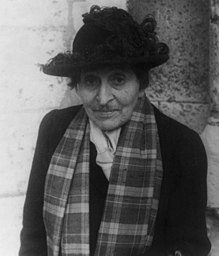| Alice B. Toklas | |
|---|---|
 Alice B. Toklas, photographed by Carl Van Vechten, 1949 | |
| Born | Alice Babette Toklas April 30, 1877 San Francisco, California |
| Died | March 7, 1967 (aged 89) Paris, France |
| Resting place | Père Lachaise Cemetery[1] |
| Nationality | American |
| Education | University of Washington |
| Occupation | Avant-garde |
| Partner(s) | Gertrude Stein (1907–1946) |
Alice Babette Toklas (April 30, 1877 – March 7, 1967) was an American-born member of the Parisian avant-garde of the early 20th century, and the life partner of American writer Gertrude Stein.
Contents
Alice B. Toklas was born into a middle-class Polish Jewish family. Her paternal grandfather was a rabbi,[2] whose son Feivel (usually known as Ferdinand) Toklas moved to San Francisco in 1863. In 1876, Ferdinand Toklas married Emelia Levinsky and they had two children: Alice and her brother Clarence Ferdinand (1887-1924).
In 1890 the Toklas family moved to Seattle, where her father was one half of Toklas, Singerman and Company.
Toklas was educated in local schools, which included the Mount Rainier Seminary, and attended the University of Washingtonwhere she studied piano.
When her mother became ill, the family moved back to San Francisco. Her mother died in 1897, aged 41.
Five months after the devastating 1906 San Francisco earthquake, Toklas left the city and moved to Paris. On September 8, 1907, the day after she arrived in Paris, she met Gertrude Stein. This marked the beginning of a relationship which lasted for nearly four decades, ending in 1946 with Stein's death.
Together they hosted a salon in the home they shared that attracted expatriate American writers, such as Ernest Hemingway, Paul Bowles, Thornton Wilder, and Sherwood Anderson; and avant-garde painters, including Picasso, Matisse, and Braque.
Acting as Stein's confidante, lover, cook, secretary, muse, editor, critic, and general organizer, Toklas remained a background figure, chiefly living in the shadow of Stein, until the publication by Stein of Toklas' "memoirs" in 1933 under the teasing title The Autobiography of Alice B. Toklas. It became Stein's best-selling book.[3]
W. G. Rogers wrote in his memoir of the couple, published in 1946, that Toklas "was a little stooped, somewhat retiring and self-effacing. She doesn't sit in a chair, she hides in it; she doesn't look at you, but up at you; she is always standing just half a step outside the circle. She gives the appearance, in short, not of a drudge, but of a poor relation, someone invited to the wedding but not to the wedding feast."[4] James Merrill wrote that before meeting Toklas "one knew about the tiny stature, the sandals, the mustache, the eyes," but he had not anticipated "the enchantment of her speaking voice—like a viola at dusk."[5]
Toklas and Stein remained a couple until Stein's death in 1946.[6]
Although Gertrude Stein willed much of her estate to Toklas, including their shared art collection (some of it Picassos) housed in their apartment at 5, rue Christine, the couple's relationship had no legal recognition. As many of the paintings appreciated greatly in value, Stein's relatives took action to claim them, eventually removing them from Toklas's residence and placing them in a bank vault while she was away on vacation. Toklas then relied on contributions from friends as well as her writing to make a living.[7]
In 1954 Toklas published The Alice B. Toklas Cookbook, a book that mixes reminiscences and recipes. The most famous recipe, contributed by her friend Brion Gysin, is for "Haschich Fudge", a mixture of fruit, nuts, spices, and "canibus sativa" [sic] or marijuana. Her name was later lent to the range of cannabis concoctions called "Alice B. Toklas brownies" (despite the fact that the "Haschich Fudge" recipe did not originate with Toklas, nor is there any record that she ever made it herself). The cookbook has been translated into numerous languages. A second cookbook followed in 1958, Aromas and Flavors of Past and Present. However, Toklas did not approve of it, as it was heavily annotated by Poppy Cannon, an editor at House Beautiful magazine. Toklas also wrote articles for several magazines and newspapers, including The New Republic and The New York Times.
In 1963 Toklas published her autobiography What Is Remembered, which ends abruptly with the death of Gertrude Stein.
Toklas's later years were very difficult because of poor health and financial problems. She died in poverty at the age of 89, and is buried next to Stein in Père Lachaise Cemetery, Paris, France;[8] her name is engraved on the back of Stein's headstone.[9]
I Love You, Alice B. Toklas, a movie starring Peter Sellers that was released in 1968, is named for Toklas's cannabis brownies, which play a significant role in the plot.
The Alice B. Toklas LGBT Democratic Club is a political organization founded in San Francisco in 1971.
Samuel Steward, who met Toklas and Stein in the 1930s, edited Dear Sammy: Letters from Gertrude Stein and Alice B. Toklas (1977), and also wrote two mystery novels featuring Stein and Toklas as characters: Murder Is Murder Is Murder (1985) and The Caravaggio Shawl (1989).
The San Francisco Board of Supervisors voted in 1989 to rename a block of Myrtle Street between Polk Street and Van Ness Avenue in San Francisco as Alice B. Toklas Place, since Toklas was born one block away on O'Farrell Street.[10][11]